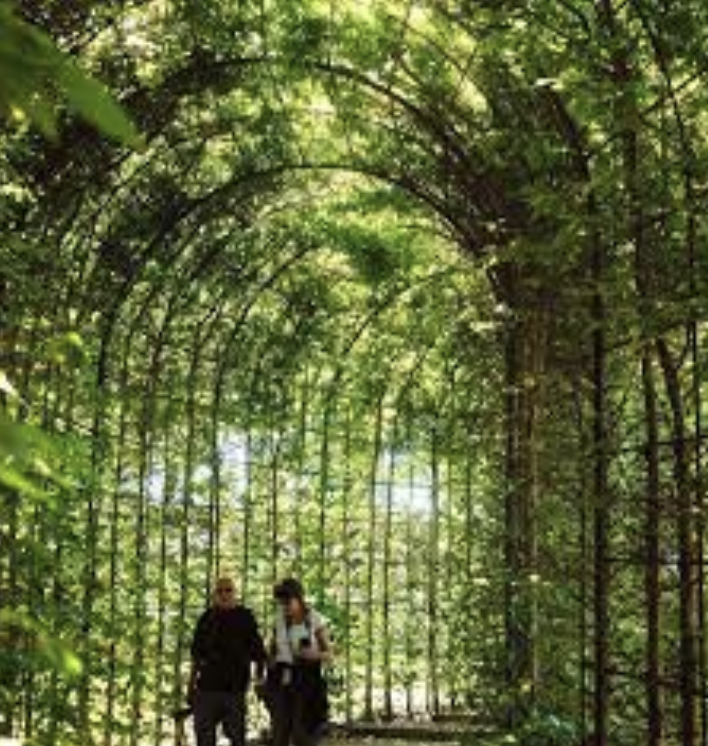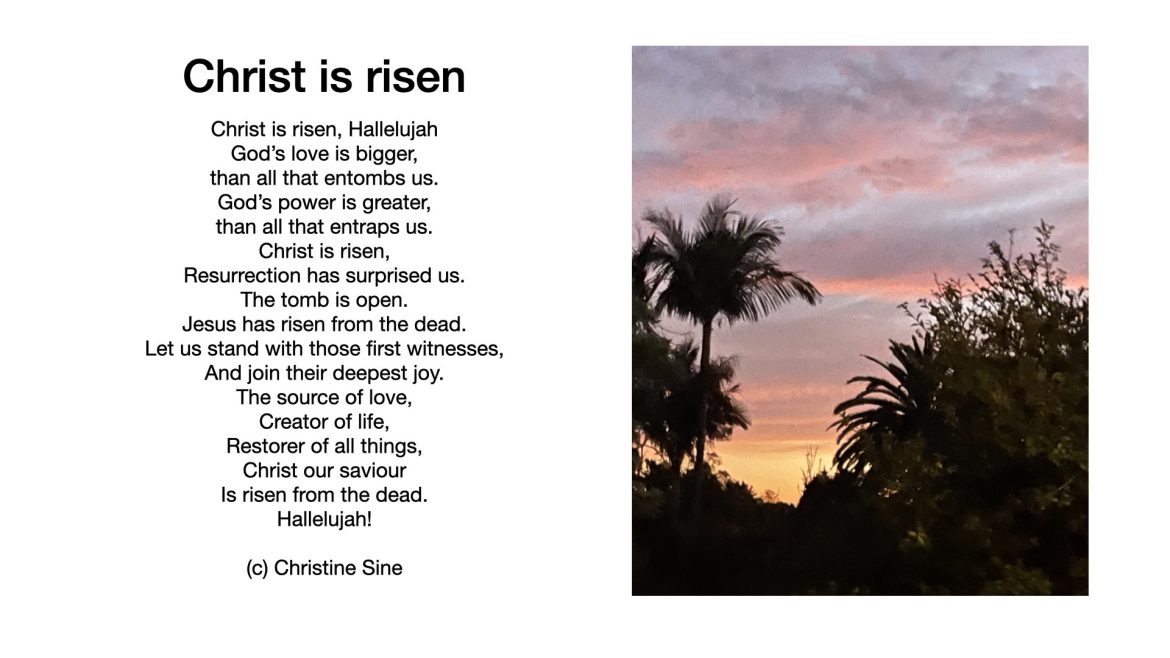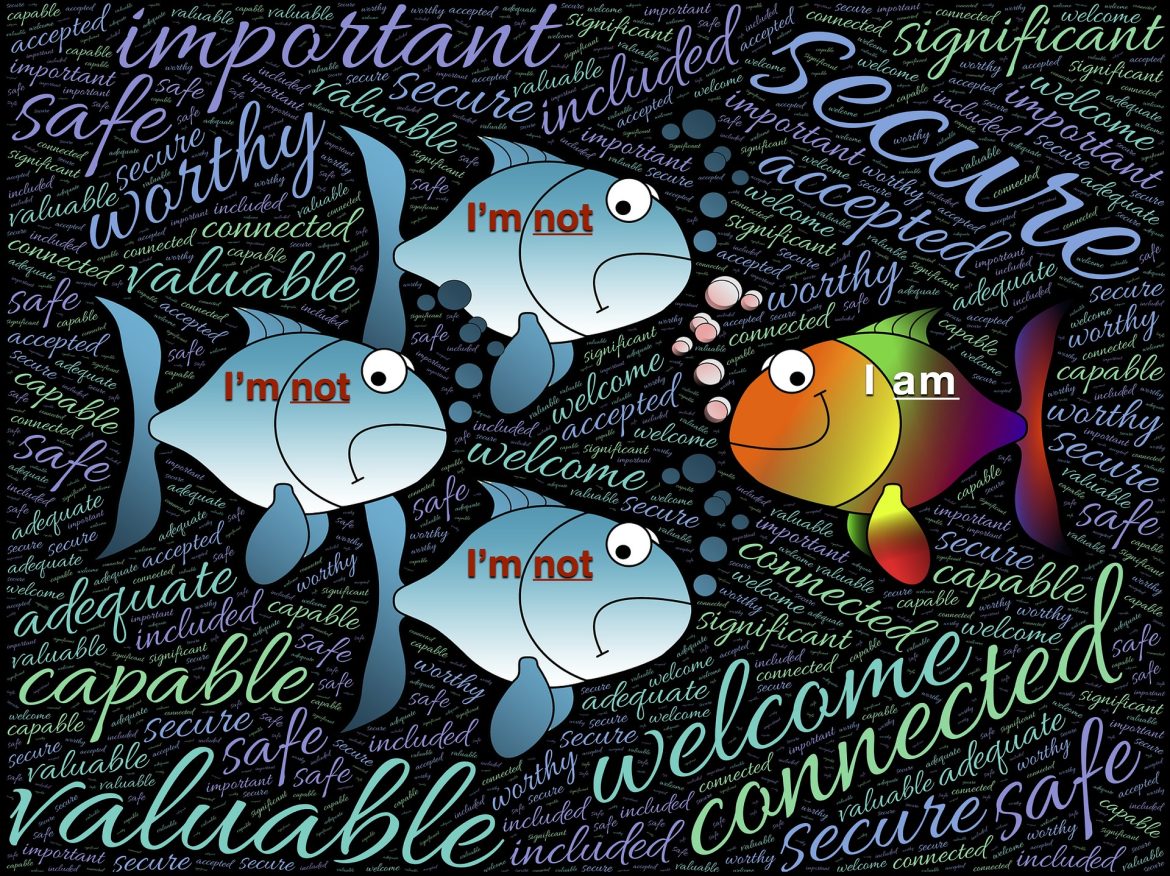by Carol Dixon & friends
An Easter Song by Stuart Brock
The Gardener
(Tune Northumbrian Traditional: Have you seen my bonny lad?)*
‘Tell, if you know where my Lord is laid,’
cries Mary, heart torn with grieving.
The Gardener looks on, his heart filled with love.
But sorrow stops Mary believing.
‘O Mary, it’s me!’ the Gardener replies,
‘Can you not see through your grieving?
A while I was gone, but now I return.
Dry all your warm tears, start believing.’
‘Lord, I believe, I understand now;
(the power of death was deceiving),
and doubt and despair are things of the past:
now I can live truly believing.’
When life is filled with darkness and fear,
or the heart is weighed down with grieving
the Gardener is near and calls us by name
and leads us through doubt to believing.
© Stuart J. Brock
*Tune:
Grateful thanks to Stuart for allowing me to use his beautiful song
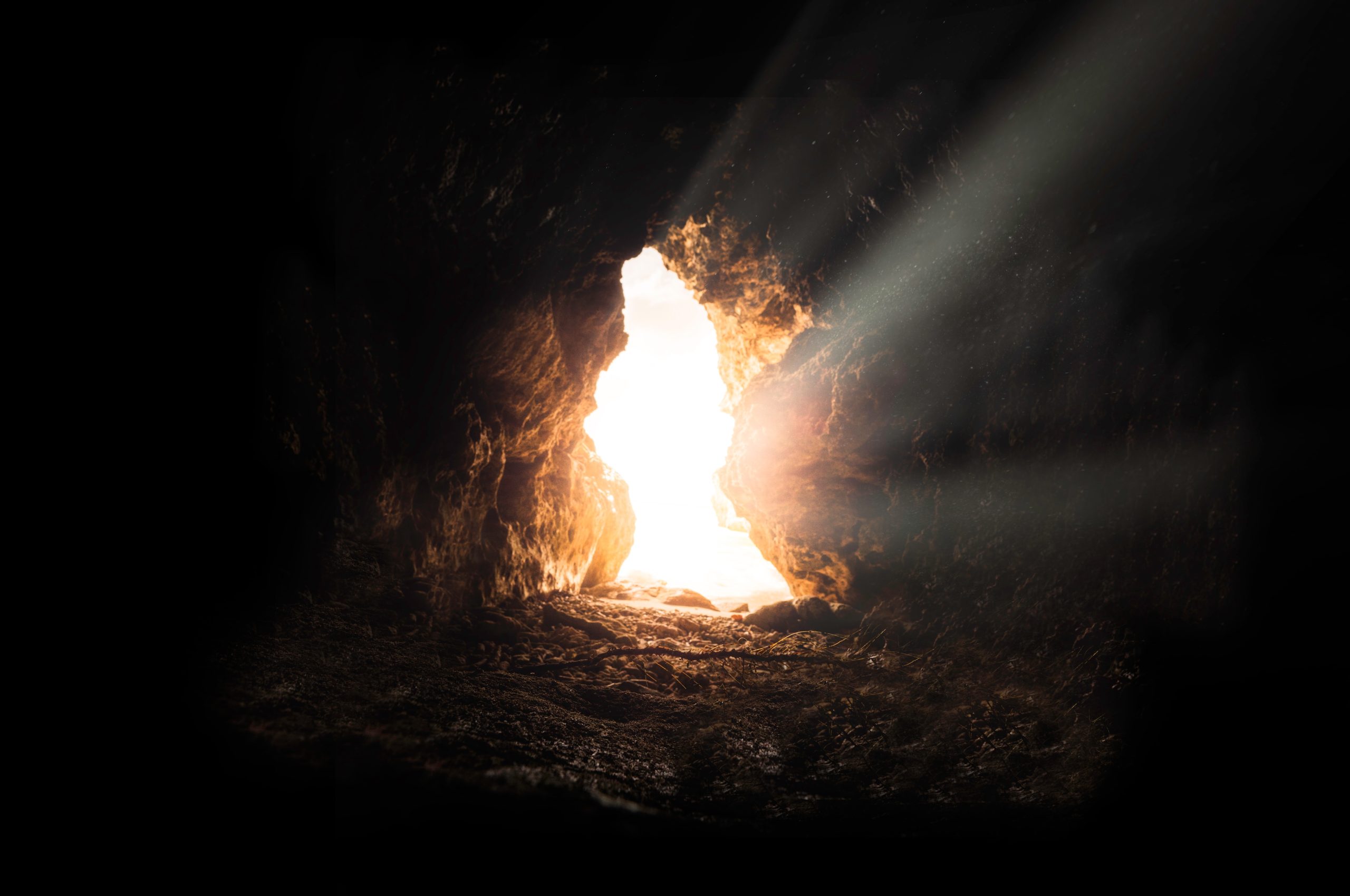
Photo by Bruno van der Kraan on Unsplash
He spoke my name
I wasn’t aware of where I was heading
but found myself back in the garden.
He spoke my name.
That was how I knew it was him.
No-one ever said my name
like that, before, or since.
I’d had to get out of the city –
the claustrophobic confines
of the upper room, the sombre
atmosphere, forced conversation,
drove me mad; so I stumbled
down the outside stair onto
the quiet paving stones below
and followed my feet.
I wasn’t aware of where I was heading
but found myself back in the garden.
I hadn’t meant to go there
yet when I reached the place I thought
at least I’d be doing something;
replacing the spices, re-arranging
the grave clothes, anything
to keep me close to him.
Then I remembered the stone,
the huge boulder blocking the way,
sealed with Caesar’s insignia,
ringed round with Roman guards.
I couldn’t bear to turn back,
empty hearted, now I’d come so close,
so I pressed on, hoping against hope
for a miracle, just a small something –
a kindly guard, or friendly passer-by –
so I could see him just once more,
at peace. Not like the last time:
barely cold, broken, lying
in his anguished mother’s arms
as we struggled to do the right thing
and prepare his battered body
before the Sabbath curfew began.
But when I reached the tomb – nothing!
No seal, no stone, no body;
an empty shell with no-one inside.
Oh God! Don’t say they’ve taken him,
defiled in death the body of the Man
I loved; who loved me, and all who
followed, with the passionate love of God.
I looked around frantically and,
in the distance, I espied a figure
in the burgeoning daylight, silhouetted
by the brightening rays of early sun.
Thank God! The gardener.
I hastened to him, falling at his feet:
‘Oh Sir,’ I said, ‘If you know
who has taken him, tell me,
so I can go and get him.’
And then I heard my name,
spoken, as if I’d never heard it before:
‘Mary!’ and I knew. In that moment
I knew everything.
He gently prised my grasping hands
aside and raised me to my feet,
and bade me tell the others
he would see them, back in Galilee.
He spoke my name.
And all my world was filled with joy –
the joy of a new beginning.
Easter Communion
Tune: Silent Witness -Handel (Have you not seen my lady?)
Lord we have seen you walking
The garden at dewy dawning;
Lord we have heard you talking
As birdsongs greet the morning;
And Lord we have met you living
Where once we thought you dead;
And we rejoice to find you
Blessing the broken bread.
Lord we have seen you caring
For those who were filled with sorrow;
Lord we have heard you sharing
Your hope for a new tomorrow;
And Lord we have felt you filling
Our lives with your love divine,
And we receive your new life
As we share bread and wine.
Easter communion midi here
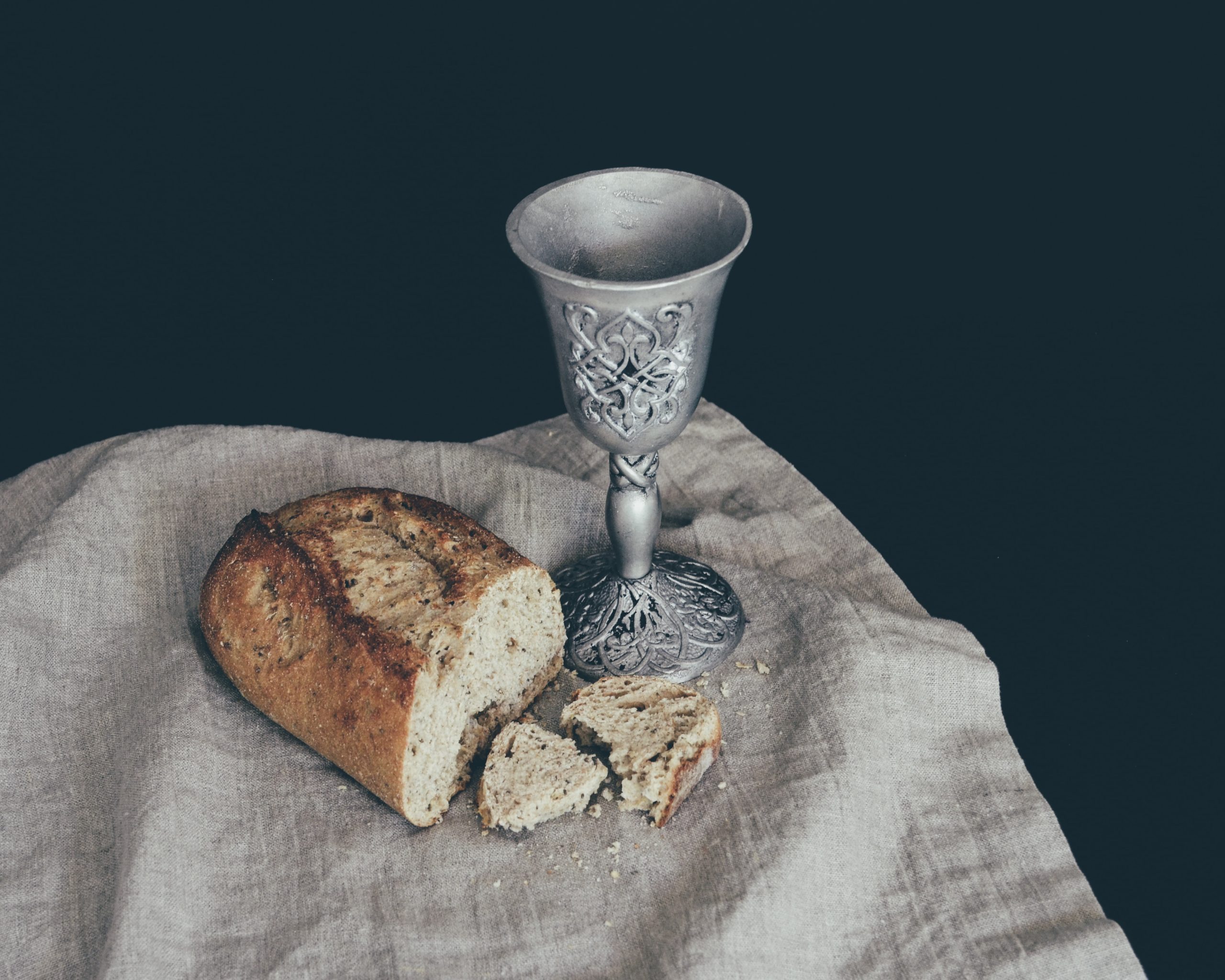
Photo by Debby Hudson on Unsplash
The Walk to Emmaus – Mary, wife of Cleopas reflects….
We were walking slowly. Taking our time you might say, for there were about seven miles to go. I’m not sure that I really wanted to return to our lodging at Emmaus. I wanted to stay in Jerusalem with the others. The other women, that is. We needed to think about what had happened to us that morning. What we had seen and heard. Even if none of the men believed us. Perhaps, just perhaps, we need not be in despair, as we had been since Friday evening. But Cleopas wanted to get away. He was heart sick with grief and disappointment. He had been so sure that Jesus was the one who would save us, which for him meant somehow getting rid of the Romans. He wasn’t exactly a zealot, you understand, but if push had come to shove, he was ready to man the barricades under Jesus’s leadership. So he had been desolate since Friday, and he was indignant that the strange message that Jesus had risen – even if he didn’t believe it – should have been given to women.
He couldn’t leave it alone. He mourned the death of our leader. He lamented the lost opportunity. He questioned me about what the men – the angels? – had said to us. I wished he would be quiet, though I didn’t say it. I had never been quite sure about Jesus as a king in this world, leading a military coup. It didn’t seem like him. It contradicted most of the things he had ever said. And I wanted to think quietly about what happened this morning. To ponder in my heart.
Then I realised there was someone walking beside us. I don’t know when he joined us, or where he came from. I didn’t think it was anyone I knew. He seemed to be listening to Cleopas’s diatribe, and my dutiful answers. Then he spoke. It wasn’t a voice I recognised, and yet…
“What is it that you are talking about?” We stopped and looked at him.
Cleopas said “You must be the only person in Jerusalem that doesn’t know about what’s been happening there these last days.” I smiled to myself. Trust Cleopas to think his concerns were at the forefront of everybody’s mind. I was pretty sure that most of the people who were visiting Jerusalem had kept well out of the way of trouble and only had a hazy idea of the matter. Cleopas continued, “How the authorities took Jesus of Nazareth who was a prophet and a teacher, and our leader, and handed him over to the Romans to be crucified. We thought – hoped that he was the one who would deliver Israel, but we can forget that now. And then, if you please, some of the women in our group,” he carefully didn’t look at me, “went to the tomb this morning and came back with a cock and bull story about him having risen from the dead. I ask you!”
The stranger shook his head and spoke rebukingly – yet I thought there was a smile in his eyes. “How foolish you are. Don’t you understand anything you’ve been told? Don’t you remember what the prophets have said?” Then he set to and explained everything Isaiah and the other prophets has said about the Messiah, and what would happen to him. It made perfect sense. Suddenly, Friday didn’t seem such a disaster. We could understand why it had to happen. I was almost happy. I felt a warm glow inside. It reminded me of that time we sat in a great crowd on the hillside and Jesus told us how we should behave.
By the time he’d finished we had reached Emmaus. As we turned into the house, the stranger seemed to be going on, but Cleopas stopped him. “It’s getting late,” he said. “Come in and stay with us.” So he came in with us. I put food and wine upon the table. We sat down and he picked up the bread. I watched his hands, fascinated. He blessed the bread, broke it, and handed it to us, with that gesture we had seen so many times. We both gasped. It was the Lord. But even as we realised, he just wasn’t there anymore.
We stared at each other. We knew that this was something we had to share with everyone. With the whole world! But first…. “We must go back to Jerusalem and tell the others” I said. “Are you sure you want to? Won’t you be too tired?” he asked.
“Tired? I feel as if I could walk all round the Middle Sea and not be tired.” So we set off back the way we had come. But oh, how differently. We discussed what Jesus had told us, making sure we understood what he meant. We laughed and rejoiced. Cleopas wasn’t grumbling now.
It must have taken us nearly two hours to get back, but it felt like just a few minutes. We burst into the room where our friends were. “The Lord is Risen!” exclaimed Cleopas. “Indeed He is.” They replied. “Simon has seen him.” Poor Cleopas. He so wanted to be first with the news. But he swallowed his chagrin and told them all that had happened and what Jesus had said to us during our walk to Emmaus.
© Fiona Middlemist
Thomas
I’ve just spent the worst ten days of my life! Everything was wonderful – then it fell apart.
That last supper with Jesus was something special – despite the undercurrents of unease and the usual bickering over which one of us, his closest friends, would be the greatest. Well we all failed that one spectacularly I can tell you. Judas most of all. I still can’t understand why he did it – betraying Jesus to the authorities. Peter didn’t come out too well either – denying he ever knew him. I must admit though, at least Peter had the guts to go with John to the trial (if you can call it that – stitch up more like). The rest of us just scattered.
I couldn’t follow him to the Cross. Seeing the Lord we loved reduced to a tortured, bleeding lump of humanity. The stench of sweat and excrement – of death, hanging in the air. But it wasn’t that I couldn’t stand. I suppose I could have steeled myself to watch his stretched out agony, the pain of listening to them taunting him, the embarrassment of his being killed as a common felon. No, it was his love I couldn’t bear. Still loving to the end. Loving them – his enemies; loving us – his unfaithful friends; loving me.
And afterwards – it was all we talked about in the upper room. Every sordid detail, over and over again. Then on the Sunday that madwoman from Magdala came in with such a tale. She’d seen him, talked to him, touched him. I couldn’t take it. I just cut and ran. When I got back the rest of them were at it. “You’ve just missed him” they said. “He’s been here. We gave him the leftovers from supper.” I thought they were having me on at first. Then I realized they meant it.
I told them straight. “You’re all crazy. I’ll never believe it – not unless I can put my finger in the nail holes and stick my hand in the wound in his side.” I turned my back on it all and walked out.
……. A week later his disciples were in the house again, and Thomas was with them. Though the doors were locked, Jesus came and stood among them and said, “Peace be with you!” Then he said to Thomas, “Put your finger here; see my hands. Reach out your hand and put it into my side. Stop doubting and believe.” Thomas said to him, “My Lord and my God!” Then Jesus told him, “Because you have seen me, you have believed; blessed are those who have not seen and yet have believed.” [John 20 v 26-29]
A prayer
Loving Lord,
often like Thomas we doubt your power
to rise above the death-like situations
in our lives and in our world.
When we recall the sudden deaths,
murders, painful experiences,
and serious illness of people around us;
When we think of the wars,
bombings, famines,
and other disasters which wreak havoc
around us, we want to run away and hide.
Help us to have the courage
to reach out and touch your scars,
borne for the world, and for us,
so that we may be healed,
renewed, and see your risen life
in the broken people and places
of our world, and acclaim you again
as our Lord and our God. Amen.

Photo by Todd Rhines on Unsplash
Watcher on the shore
‘There stood Jesus on the beach; but the disciples did not know it was Jesus.’ [John 21: 4]
Sitting on the shore
watching the boats,
he reflected on past
events. He’d had a good
three years – the best
and, no matter what
the future held, nothing
could take that away
from him, or them.
He regarded them more
closely; hearing their
muted curses across the still
water he recognised how
frustrated they must be –
experienced fishermen
that they were – working
all night without success;
perhaps they wished they
were back to catching men!
He looked at the sea
again and saw the dark
shadow of a shoal on the
starboard side of the boat.
How simple and clear cut
everything was when viewed
from a distance, removed
from the involvement of it all.
To be able to look on
with detachment while still
caught up and caring
about the task in hand;
that was the answer –
the God’s-eye view.
‘Cast your nets on the
other side,’ he called
and stirred the fire
to cook the breakfast
they were bringing in.
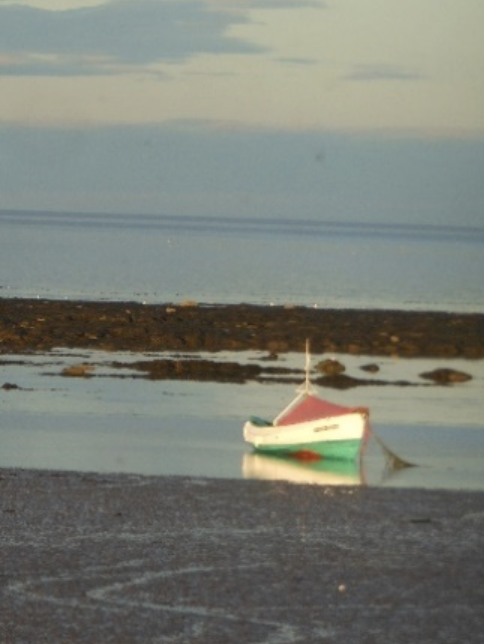
At the lakeside
It was the lad – John – who saw him first;
we were too busy hanging onto the bulging net to notice him,
and maybe just a bit resentful at a stranger on the shore
telling us our business.
‘It’s him’, he said. ‘Who?’ I asked, as I straightened up.
‘It’s the Lord, who else?’ he replied,
with a grin too wide for his face.
I shaded my eyes against the low dawn light and stared
and my heart leapt – and froze – within my chest.
I grabbed my garments and plunged over the side of the boat,
sinking to waist level in the waves as I had before
when he’d called me to come to him across the water.
Struggling up the shingle I fell in a heap at his feet
and he grabbed my hands as he had the other time
and hauled me up till we were eye to eye.
The others arrived, bustling up the beach, bringing fish
to lay on the fire beside the little loaves already baking there.
‘Come and eat’ he said as he broke and shared the feast.
Afterwards when everyone was sated and settled
he looked at me across the fire. ‘Walk with me’, he said
and we set off along the shoreline.
‘Simon, do you love me more than these?’ he asked,
indicating the others sprawled out on the sand.
‘Yes Lord,’ I answered automatically. ‘You know I love you.’
‘Feed my flock’, he said.
A little further on he asked again: ‘Simon do you love me?’
(Why does he call me Simon? My name is Peter – the Rock
– the name he gave me himself. Not much of a rock-man now,
haunted as I was by my denial and desertion,
as he went to his death).
‘Yes, Lord,’ I said again. ‘You know I love you.’
‘Look after my lambs,’ he said.
And then, O agony, he asked a third time:
‘Simon, do you love me?’.
He gazed into my tear-filled eyes, my tear-filled heart,
my tear-filled soul and we were back in the courtyard
beside another fire. ‘Lord, you know everything’ I cried.
‘You know I love you.’
‘Lead my sheep,’ he said, and smiled;
and the sun rose in the sky, and the sea shimmered,
and the world was wonderful.
I looked back and saw the lad was following.
‘What about him, Lord?’ I asked.
He turned, regarding John with that look of love
reserved for children and for all pure hearted ones.
‘Not your concern,’ he chided gently.
‘You, you follow me.’
And I did.
to the end….
So can you.

Photo by Sebastien Gabriel on Unsplash
I Corinthians 15 – He is risen
He is risen, He is risen.
Listen to the message which was given to you,
The good news of our Lord Christ,
Hear now once again the word you have received,
And on which your faith stands firm:
He is risen, He is risen.
If it was for nothing that you first believed,
Jesus Christ died for our sins,
How we told how he was raised to life again,
And he lives that we might live in him:
He is risen, He is risen,
Alleluia, He is Lord.
He is risen, He is risen,
Alleluia, He is Lord.
Now to him who gives us all that we can dream,
Only God whom we adore,
Jesus Christ who died for all our sins;
Glory now and evermore.
He is risen, He is risen,
Alleluia, He is Lord.
He is risen, He is risen,
Alleluia, He is Lord of all. © Simon Dixon

Photo by Mohamed Nohassi on Unsplash
 Prayer cards are available in the shop for many occasions and seasons–from everyday pauses and Lenten ruminations to breath meditations and Advent reflections, enjoy guided prayers and beautiful illustrations designed to delight and draw close. Many are available in single sets, sets of three, and to download–even bundled with other resources!
Prayer cards are available in the shop for many occasions and seasons–from everyday pauses and Lenten ruminations to breath meditations and Advent reflections, enjoy guided prayers and beautiful illustrations designed to delight and draw close. Many are available in single sets, sets of three, and to download–even bundled with other resources!
by Louise Conner – Originally posted here on the Ecological Disciple on March 16, 2023.
The Examen, a prayer exercise first practiced by Ignatius of Loyola, the founder of the Jesuits, leads a person through a review their day in the company of God, often twice a day (at noon and at night). Typical steps are to: express gratitude, review the day, name your emotions, seek forgiveness, and ask grace for tomorrow. Variations on the examen have been developed over the years to help people focus on particular areas of their faith.
An Ecological Examen
Out of this tradition, the Ecological Examen asks you to reflect on your personal relationship with creation, to acknowledge and change your ways, and to promote ecological justice by standing in solidarity with those most affected by environmental harm. This particular Ecological Examen prayer is a collaboration between Pray as You Go and the Ignatian Solidarity Network
There are six steps. To begin the examen, place yourself in a posture that allows you to be open to the ways the Spirit is working in you.
The examen text is printed below with accompanying images. Take time to reflect and pray between each segment. If you would like to have the pace set for you, click on the arrow below Step 6 and listen to an eight-minute audio recording of the ecological examen. Its pace is slow enough to allow time for reflection and prayer between each segment.
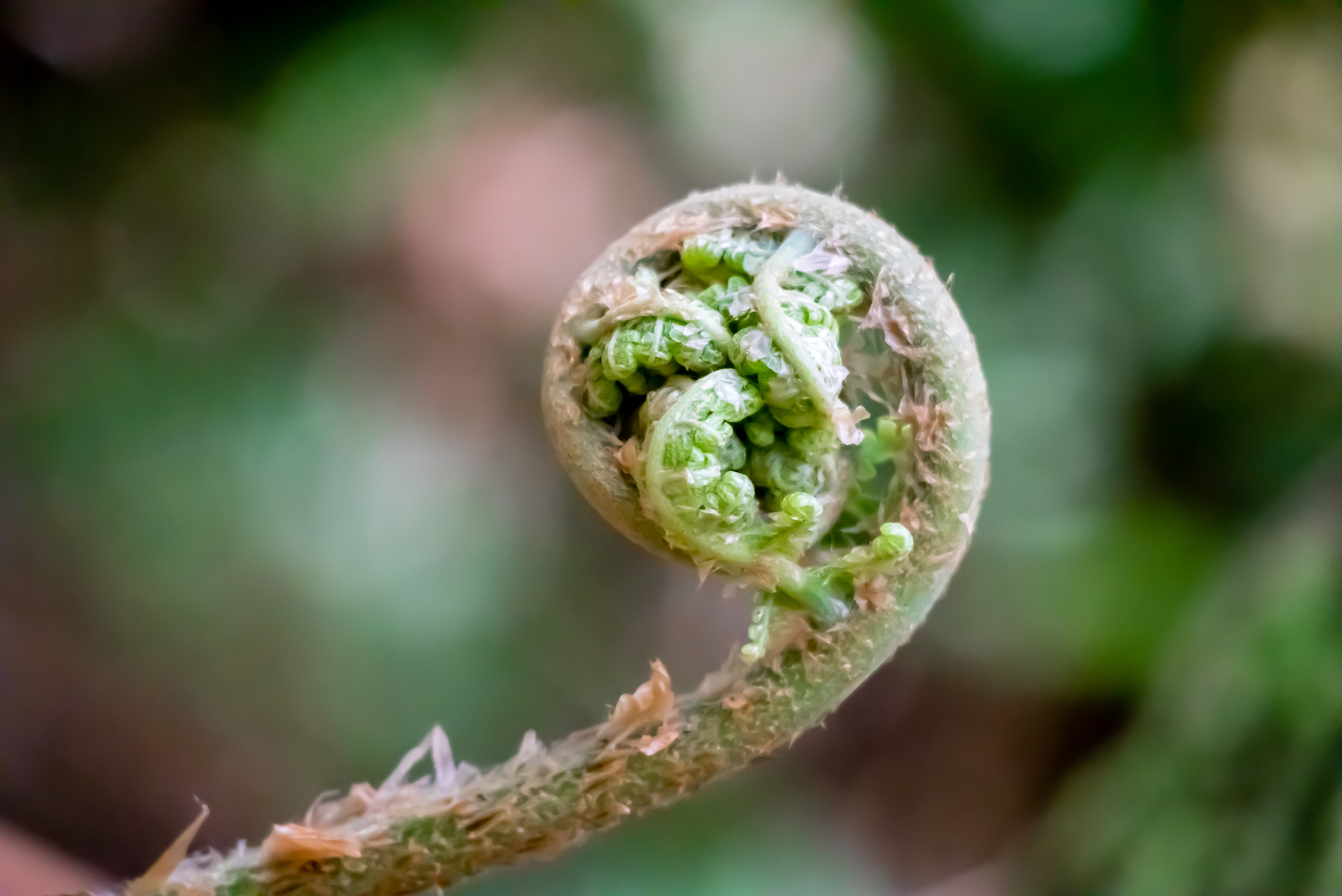
1. Gratitude
I give thanks to God for creation and for being wonderfully made. (Where did I feel God’s presence in creation today?)

2. Awareness
I ask for the grace to see creation as God does – in all its splendor and suffering. (Do I see the beauty of creation and hear the cries of the earth and the poor?)

3. Understanding
I ask for the grace to look closely to see how my life choices impact creation and the poor and vulnerable. (What challenges or joys do I experience as I recall my care for creation? How can I turn away from a throwaway culture and instead stand in solidarity with creation and the poor?)

4. Conversion
I ask for the grace of conversion towards ecological justice and reconciliation. (Where have I fallen short in caring for creation and my brothers and sisters? How do I ask for a conversion of heart?)
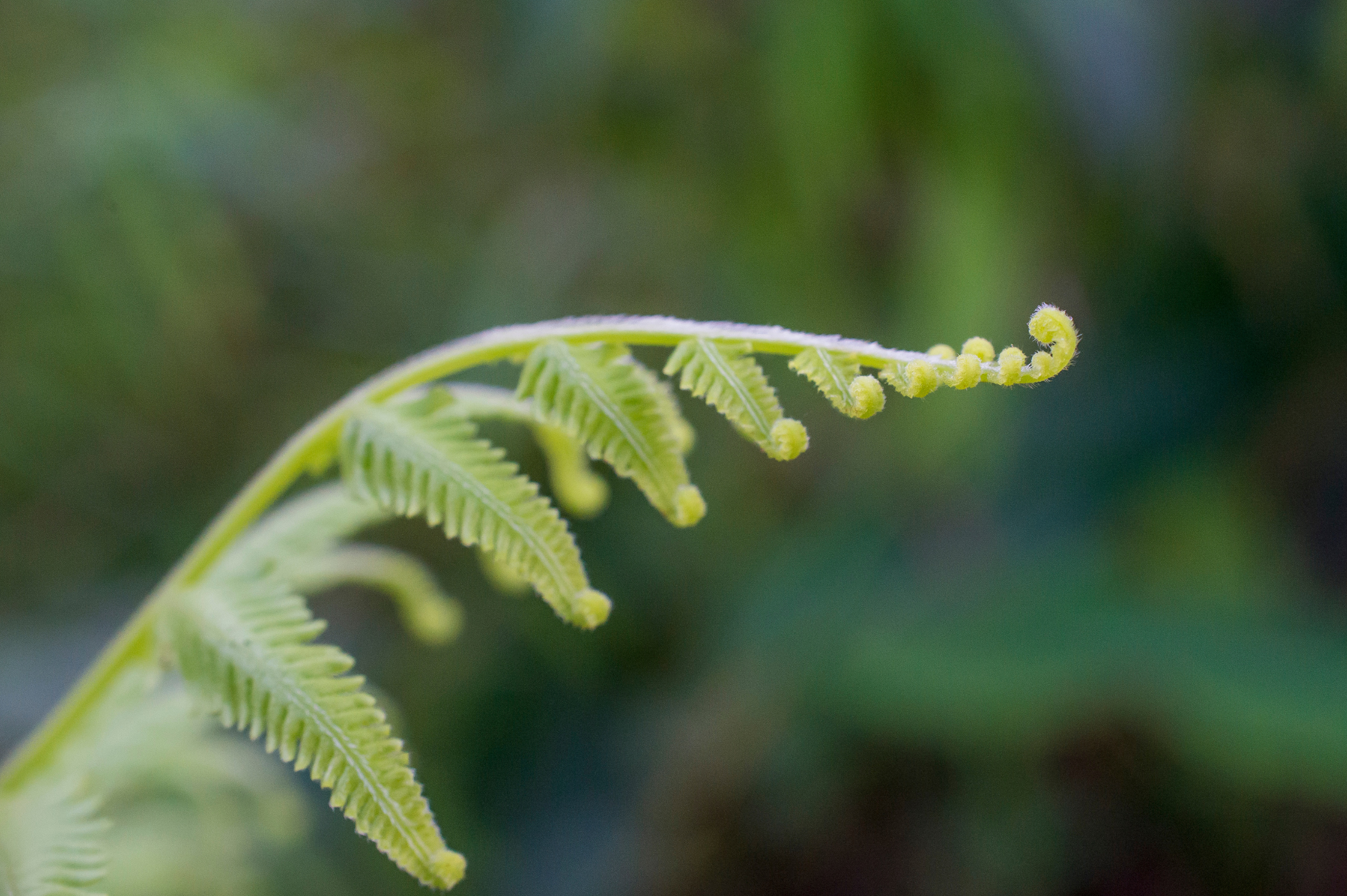
5. Reconciliation
I ask for the grace to reconcile my relationship with God, creation, and humanity, and to stand in solidarity through my actions. (How can I repair my relationship with creation and make choices consistent with my desire for reconciliation with creation?)

6. Closing Prayer
I offer a closing prayer for the earth and the most vulnerable in our world.
I encourage you to experiment with this examen and discover if using it (either just once or regularly) helps you to be more mindful throughout the day. Is it a practice that deepens your relationship with God? If you have other practices that are already part of your spiritual discipline, is interspersing new ones such as this refreshing and helpful in your growth as an ecological disciple? If you have another practice to recommend to others, we would love to hear about in the comments section.
To learn more about the examen prayer, click here.
Feel free to email me at info@circlewood.online or leave a comment below.
– Louise
 Simple Ways to Care for the Earth
Simple Ways to Care for the Earth
We are creating a Godspacelight resource that provides affordable and simple actions we can all take to make a difference. What are some simple steps you have taken to live more responsibly and sustainably? Let us know at godspacelight@gmail.com.
Originally posted here on April 17th, 2015. Featured Photo is an alaskan landscape photo by Coe Hutchison. Used with permission.
Sunday April 22nd is Earth Day but why should Christians care? Over the next few days I plan to post statements from several different religious organizations that are concerned for creation.
The post below comes from earthministry.org. It very eloquently articulates my own reasons for being concerned for God’s good earth. Earth Ministry is a Seattle based creation care advocacy group. They have initiated the Washington Interfaith Power and Light project which organizes an interfaith response to climate change.
Spirituality
Creation itself inspires us and calls us to care. Many people have had their most profound spiritual experience in nature. As we behold the power and love of God in a mountain range, a sunset, or in the timelessness of the ocean, we can’t help but be moved. But creation also includes humans – our families, communities, and created landscapes. God created all things of Heaven and Earth and God is our inspiration to care for both wild places and our own cities and backyards.
Stewardship
Psalm 24 states that “the Earth is the Lord’s and all that is in it, the world, and those who live in it.” Humans simply hold the Earth in trust for God. We are tenants here, called to care for the creation on behalf of future generations and all species. The Bible calls us to “till and keep the garden” and names human beings as the trustees of creation. Because God created all the Earth and all of us, creation is beautiful and good and sacred. We are called by our devotion to God and our love for God’s works to protect it.
Sustainability
At the heart of sustainability is the goal of meeting the needs of the present without compromising the ability of future generations to meet their own needs. In a world of finite resources, those among us who have more than enough must address patterns of consumption so that we can provide for all. Acquiring more “stuff” has a direct effect on the sustainability of the planet and on the quality of life for people around the globe. The good news is that more and more people are realizing that spiritual emptiness can’t be filled by consumption. What makes us happy is intimacy – intimacy with self, with others, and with God. In the end, sustainability means seeing ourselves and our neighbors as children of God, not as consumers or competitors for Earth’s resources.
Justice
Justice means that in addition to providing aid to our neighbors, we are called to change societal systems that cause poverty, injustice, and environmental damage in the first place. It goes beyond helping to meet physical needs to creating a society with laws and policies that allow the needs of all Earth’s inhabitants to be met. Care and responsibility for the “least of these among us” is a central tenant of Christianity and has a direct connection to environment issues. The impact of environmental degradation falls most heavily on the people around the world who are least able to mitigate these impacts — poor and vulnerable populations. It also disproportionally affects fragile plants, animals and ecosystems. Working for justice calls us to channel our faith into power, to call for social and environmental justice at the local, state and national level.
 Simple Ways to Care for the Earth
Simple Ways to Care for the Earth
We are creating a Godspacelight resource that provides affordable and simple actions we can all take to make a difference. What are some simple steps you have taken to live more responsibly and sustainably? Let us know at godspacelight@gmail.com.
Christ is risen, He is risen indeed! These words echo in my heart on this day after Easter Sunday and I am so glad that Easter is notarially over yet. “Resurrection surprises us, but it never surprises God. The Easter season does not end with Easter Sunday however. It extends until Pentecost and celebrates both the resurrection of Jesus and also the many ways the resurrected Christ comes to meet us and is expressed through our lives.” (Meditation Monday: Living in the Glow of Easter).

There were some great posts published during Holy Week on Godspace. If you missed out last week it is not too late to read these. Joy Lenton’s Shift: Receiving a New Life and Identity in Christ and Lilly Lewin’s Freerange Friday: A Very Different Holy Week are must reads, as is Carol Dixon’s A Reflection for Holy Week. It is more than a reflection, it is a beautiful service outline that could easily be used as a post Easter retreat time. April Yamasaki’s You Are My Hiding Place is also beautiful and worthy of time slept in meditation. You might also like to check out my Holy Saturday Prayer which I posted on Instagram and Facebook this week.
I love this season of Easter. Here in Seattle, not only is spring bursting into bloom all around me, but the lengthening of days and the warmer weather immerses me with a warm glow of exultation and wonder. This week it is my hyacinths and camellias that are in full bloom. Next week the Asian pear will join them and not long behind will be the tulips and then the apple blossoms. I feel as though our celebration of Easter should extend as long as the springtime here in Seattle so I am always grateful for the extent of the Easter season. It’s a good time not just to plant new seeds in the garden but also in the world around us. Even for those in the Southern Hemisphere, it is worth remembering that in nature, most seeds are scattered in the autumn. Seeds of love, seeds of hope, seeds of compassion and caring. Ask yourself what you can do to fully live out the resurrected life of Jesus this year.
My love of this season and my growing concern for climate change and God’s care for creation encouraged me to make Climate Change and Creation Flourishing. Our focus for the Easter season. In May we will have solar panels installed, and regularly challenge ourselves to consider how we might live more sustainably on the earth, something that I know many of you are passionate about too. As I mentioned a few weeks ago, I believe “Climate change requires spiritual transformation. We need to transform our view of the Bible to see the ecological underpinnings of the story”.
Earth Day and Earth Sunday are only a couple of weeks away, so this is a good time to start thinking about how we responsibly and sustainably care for God’s creation and those whose lives are so drastically impacted by changing weather patterns and rising sea levels. Don’t forget to check out our many and varied creation care resources. Last week I mentioned that we are putting together our own Godspacelight resource “Simple Ways to Care for the Earth.”, on affordable and simple actions we can all take to make a difference. We would love this to be a community effort so please consider contributing to this. What are some simple steps you have taken to live more responsibly and sustainably? Let us know. As we want this to be available by Earth Day we need these by the end of this week.

Next Sunday is known as Holy Humour Sunday. I only learned about this a few years ago, but resurrecting the practice of humour seems like a great plan for the coming week. Sadly many of us don’t really feel its OK to laugh and have fun in church. We grew up with an authoritarian God who is always serious and never playful. Now it’s time to change. So think of ways to bring laughter, both into your life and into your church and let us know what happens.
Many blessings on you this Easter season
May the life of the Triune God be with you this day.
Love of the Creator fill your heart,
Light of the Risen One guide your steps,
Hope of the Indwelling One teach your minds.
Life of the Three sustain you,
Love of the One encircle you
Now and always, this day and forever.
Christine Sine
by Christine Sine
It is the day after Easter and I sit here in the glow of the resurrection, immersed in its joy and surrounded by its celebration. It is hard for us, with our foreknowledge of the events of Easter Sunday, to comprehend the incredible joy the women who came early to the tomb must have felt. They came with heavy hearts and eyes swollen and red with weeping but left with joy and dancing. Resurrection had broken into their lives.
Can you imagine Peter, coming to the tomb riddled with guilt because of his betrayal of Jesus? He too was surprised by resurrection, not just encountering the risen Christ, but seeing that new life emerge in himself as he wept tears of repentance and joy.
I can imagine, around them, spring bursting into bloom too, a reminder to these first disciples and to us too that resurrection was always part of God’s plan from the beginning of time. Resurrection surprises us, but it never surprises God. The Easter season does not end with Easter Sunday however. It extends until Pentecost and celebrates both the resurrection of Jesus and also the many ways the resurrected Christ comes to meet us and is expressed through our lives.
This weekend I realized something else startling, profound but quite simple – we don’t come to Jesus, Jesus comes to us.
So often we talk about “coming to Jesus” as though we are the ones who control what happens. But we aren’t. Jesus comes to us, as he did to Mary in the garden. The work of resurrection, revelation and transformation lies squarely on his shoulders. And he knows what I need. Nothing is asked of us except a willingness to listen and be willing to walk with him on a new journey into a new way of life.
As I read the accounts of Jesus post resurrection appearances over the weekend, I was stunned by the messages that I so often and so easily gloss over. Messages that seem so appropriate for the post COVID-19 world in which we live.
I look at the disciples and Jesus followers and and I am reminded that Jesus comes to us, the presence of love comes to us, when we are in the place of grief and despair and draws us into the light of a bright and shining day. It doesn’t mean that life is the way it was before, but does mean that change and transformation are possible because Jesus is still with us.
Jesus comes in resurrection glory:
- When I grieve and am full of despair
- WhenI am full of fear
- When I am confused
- WhenI am filled with guilt
- When I doubt
- When I have lost my faith
- When my hopes have been shattered.
- When I feel lost and alone
- When I do not understand
Jesus comes in unexpected places and to unexpected people:
- he come to us when we weep in the garden
- he waits in the empty tomb when all our hopes and expectations have been turned upside down
- he comes to those whom no one will believe
- to those who walk on a journey of confusion and bewilderment
- he penetrates beyond the locked doors of our hearts
- he meets us on the beach when we are going about our ordinary everyday work and asks us to start a new journey
Where has Jesus come to you this week? What are you struggling with in this turbulent situation in which we all find ourselves that you need to feel the presence of Jesus in your life?
Sit for a few minutes breathing in and out quietly. Watch the video below. Reflect on your own experiences over the season of Easter. In what ways have you been surprised by resurrection? What new things are you aware of that are emerging into life? How does God ask you to nurture them into maturity in this ongoing Easter season?
Now close your eyes. Take some deep breaths in and out and Allow Jesus to enter into your soul.
Sit still,
Let the presence of Almighty God
Embrace you.
Breathe deeply
Allow the love of the Glorious One
To still the turmoil of your soul.
Listen carefully with an open heart.
Hear the words of eternal truth.
Let them bring you life
In the midst of chaos.
(Christine Sine April 2020)
by Joy Lenton
Featured photo: identity attitude by John Hain at pixabay.com
“Your old sin-loving nature was buried with him by baptism when he died; and when God the Father, with glorious power, brought him back to life again, you were given his wonderful new life to enjoy.” — Romans 6:4 TLB
A shift
There’s a shift
where identity used to sit,
like an old cardigan,
well-worn, moth-eaten
but familiar,
because it became part
of me, what I always wore.
Now I don’t know what fits
me anymore,
or suits the woman
I have become
since the earth shook, since Sunday,
and a man took
on death to set us free.
Tombs broke open
and people were raised
to life again,
like they had never died,
restored to their
loved ones, their families,
as if they’d
never left them bereft.
And it is whispered
that this world
is just a stepping stone
to somewhere
better, a place of beauty
where we can sit
and think and dream and breathe,
and bask in who we are,
who we were created to be.
© joylenton
Do you ever find yourself accepting the false identity which others bestow on you? It’s all too easy for us to judge one another, isn’t it? Or to be on the receiving end of someone’s misguided, mistaken opinion of us.
Perhaps your parents fail to see you as the quietly confident adult you’ve become, and can’t resist remembering you more as the awkward, gawky, insecure child you once were.
Well now you can exhale, my friend. There are no judgments here. But even better news is to know that God does not judge us by our faults and flaws.
Because once we’ve come to faith in Christ, we are made new in his eyes and seen through the lens of accepting forgiveness and love.
You and I are not our failures and mistakes. Oh no. We are beloved children of God, redeemed through our faith in Christ.
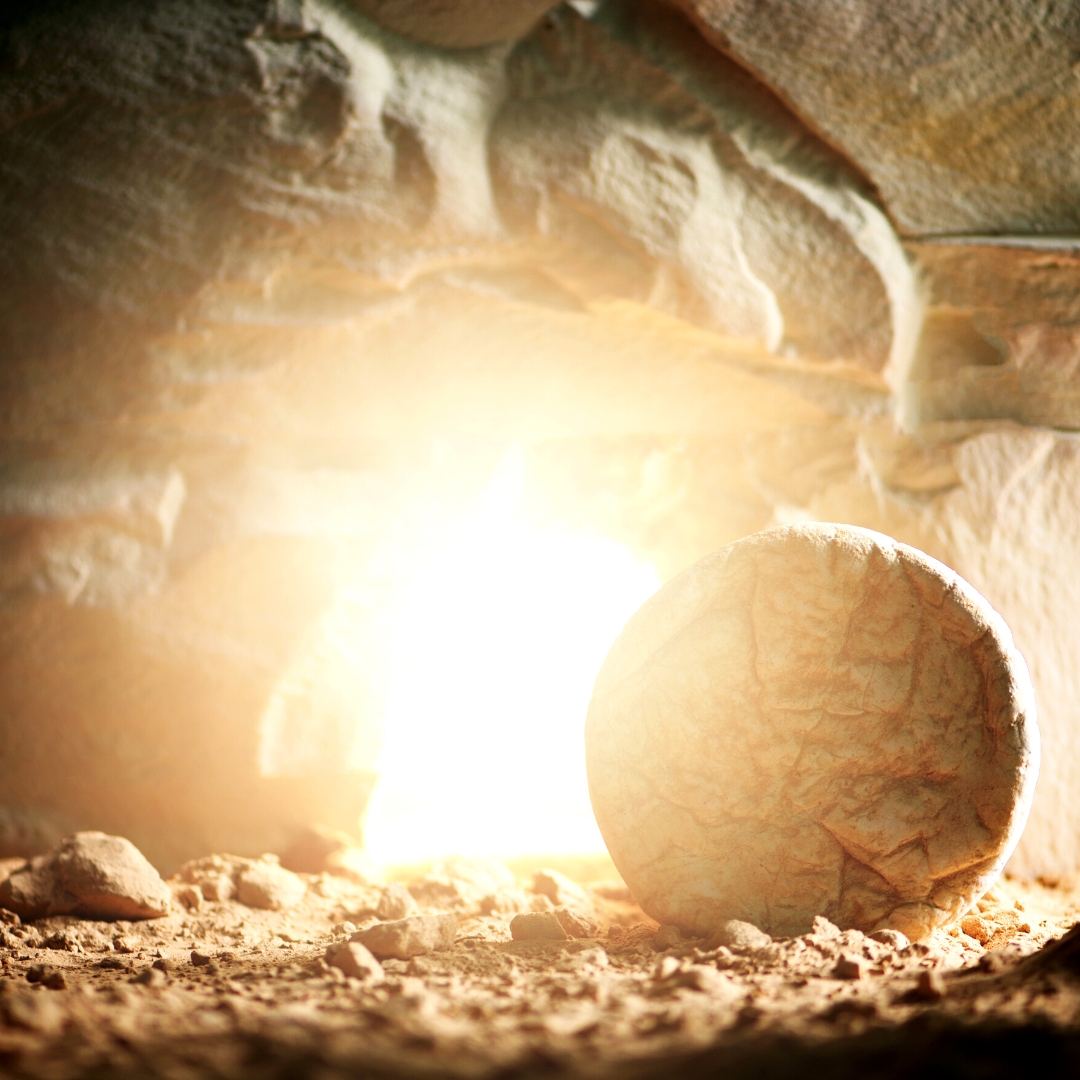
Photo from canva.com.
Father God,
One of the major shifts we experience as people of faith in Christ is the new identity he bestows on us.
Instead of defining ourselves by our upbringing, education, achievements or titles, we are defined in him by our faith, our change of heart and mind, our enlivened spirits, our altered attitudes and behaviour, and our surrendered souls and lives.
Our old ways of being and flawed patterns of behaviour do not serve us well anymore, unless they’ve been passed through the sieve of Scripture, which holds up a mirror to show us our true selves.
Thank you for the gift of a renewed identity. Help us to live it out in ways that please and bring joy to your heart.
Amen

Photo from canva.com
 Looking for hospitality inspiration? We have an entire resource page dedicated to hospitality. Find recipes and reflections on numerous hospitality topics, including Celtic hospitality, prayers, and liturgies. Click on Hospitality for more!
Looking for hospitality inspiration? We have an entire resource page dedicated to hospitality. Find recipes and reflections on numerous hospitality topics, including Celtic hospitality, prayers, and liturgies. Click on Hospitality for more!
This year, Holy Week for me has been a challenge and not at all normal. Not at all as I had hoped it would be. In the past I’ve walked through Holy Week helping others engage the story through posts, photos and meditations on the symbols and happenings of the last week of Jesus’s life. But this Holy Week, I have barely paused to light a candle for my own reflection. I’ve been living in the land of grief, in the valley of anger. As one of my friends said, anger and grief are probably the true emotions of the first Holy Week, especially Good Friday when the disciples didn’t understand why this was all happening and were broken hearted by the horrific death of their friend and rabbi. I too am broken hearted this Good Friday.
On the morning of March 27, 2023, I was walking our dog Jake down near the freeway, our neighborhood is in a very urban area near downtown Nashville. Over twenty police cars flew past over the course of 5 minutes. All types of cars, unmarked and well marked, with sirens blazing. I knew something bad had happened. I found out about an hour later, that at 10:13am, a young person shot their way into Covenant Christian School killing three nine year old students, the custodian, the headmistress and the substitute teacher of the class of nine year olds. This is a small school of around 200 students from kindergarten to sixth grade. Because of it’s location, many people don’t know their is school with in the church. I am in this neighborhood, right across the street from the church and the school twice a week. The church sits up on a hill, like Hogwarts in it’s gothic splendor. They host lost of concerts there. My brother was a church elder there for many years. To honest, this is the posh part of town where people don’t expect violence, especially not a school shooting. But sadly, the state of Tennessee has some of the most worst gun laws in the country. Anyone can get a gun without a background check. There is not a waiting period before a gun purchase, permits required. There are no Red Flag laws, so a person with a mental health problem can easily walk into five different gun stores and purchase weapons. This actually happened in the weeks before the shooting. The entire city of Nashville is in shock and grief. This Holy Week has been filled with funerals and burials. And protests. Students are tired of having shooter drills in school. They know that this doesn’t happen in any other country in the world. Only in America do we care more about guns that we do people! People have showed up at the State Capital that is here in down town Nashville and have let their voices be heard. Families with young children have marched with signs to end gun violence. Students have walked out of class and teachers have said they wan to teach not carry a gun! (one of the worst ideas the State Government has is to allow teachers to carry guns in schools) Students from Fisk, Vanderbilt, Belmont University have planned protests and people of all ages have shown up from all over the state to tell the state legislature that ENOUGH IS ENOUGH! While the people are crying out for change and smart gun control laws. There is a bill going through the State Legislature, right now, that would change the age to buy a gun from 21 to 18. You cannot legally buy a beer until you are 21 in the state of Tennessee, but these so called law makers think 18 year old should be able to walk in a buy a gun no education required. We have to all take driving classes and take tests and get a license to drive a car, but not a gun.
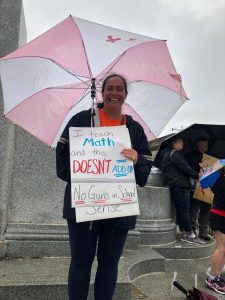
There is lots more that you may of heard on yesterday’s news about kicking out three elected officials who represent the largest cities in our state because they interrupted the house procedures because no one seemed to be listening to the people who want to end gun violence NOW. Two of these leaders happen to be young and black. My anger and frustration grew and my Holy Week practice changed.
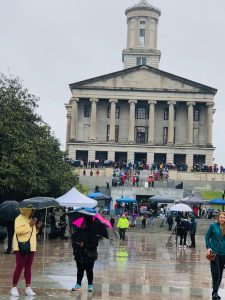
So on Maundy Thursday I went from a protest at the state capital in the morning ( the students stayed for 12 hours! ), to praying the Stations of the Cross in the afternoon. Walking the Way of Jesus. In the center of the stations the church set up a beautiful labyrinth to pray. I truly needed to pray the labyrinth after the experience of this week. I know that praying a labyrinth can calm my mind and focus my heart back to God. Labyrinths were often prayed during Holy Week by people who were becoming full members of the Christian community in preparation for their baptism. And the stations of the cross were put in the Cathedrals in Europe as mini pilgrimages when a pilgrimage to the Holy Land was too dangerous and too costly. Both are pilgrim prayer walks that help us retell and relive the story of Jesus. I love praying the labyrinth. The path winds into the center and back out the way you walked in. You cannot get lost in labyrinth. You might walk in feeling lost, but the path winds into he center which for me, has always represented the hand of God. You can walk in carrying with you a question and walk out maybe not with an answer, but with much more peace and a knowledge that God is with you in all of it. I just sat in the center and let God holds love hold me. It’s what i needed this Holy Week. I needed to take off my coat of anger and let God have it to hold. If you haven’t prayed a labyrinth as a prayer practice, I encourage you to find one and let yourself pray with your feet.
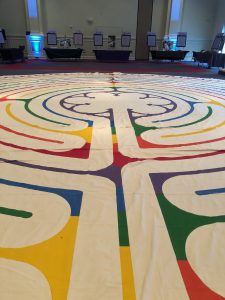
How is your Holy Week going? Where are you today in your Practice? Do you need another week? We can take next week if we need it to walk with Jesus through Holy Week because it’s Orthodox Easter on April 16h this year. We can have a “do over” or just take time to pause again and reflect on the life and suffering of Jesus.
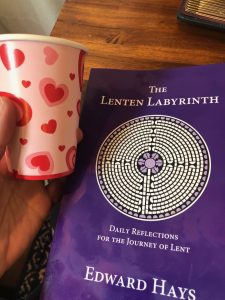
I usually invite people to pray with their cups during Holy Week. This week my cup has felt either filled with anger or very empty.
Today, on this Good Friday, what is in your cup? Do you need to pour out some things like I do? Do you need to pour out anger, bitterness, fear, busyness, etc in order for you to drink in the love of Jesus? We have been invited by Jesus to drink from the cup of love rather than the cup of hate and bitterness. Each day, each hour we are offered the cup of His Love!
What cup are you drinking from today? Talk to Jesus about what is in your cup.

Jesus thank you for taking the Cup of suffering for all of us! For drinking in the brokenness of our world. For suffering with us in the pain of school shootings, death and all of the pain of our world. Thank you Jesus that you have given us the Cup of Salvation. And thank you that you have given us the Cup of Love to drink from each day, each hour, so we can pour out your great love to our world. AMEN
As an Amazon Associate, I receive a small amount for purchases made through appropriate links.
Thank you for supporting Godspace in this way.
When referencing or quoting Godspace Light, please be sure to include the Author (Christine Sine unless otherwise noted), the Title of the article or resource, the Source link where appropriate, and ©Godspacelight.com. Thank you!

